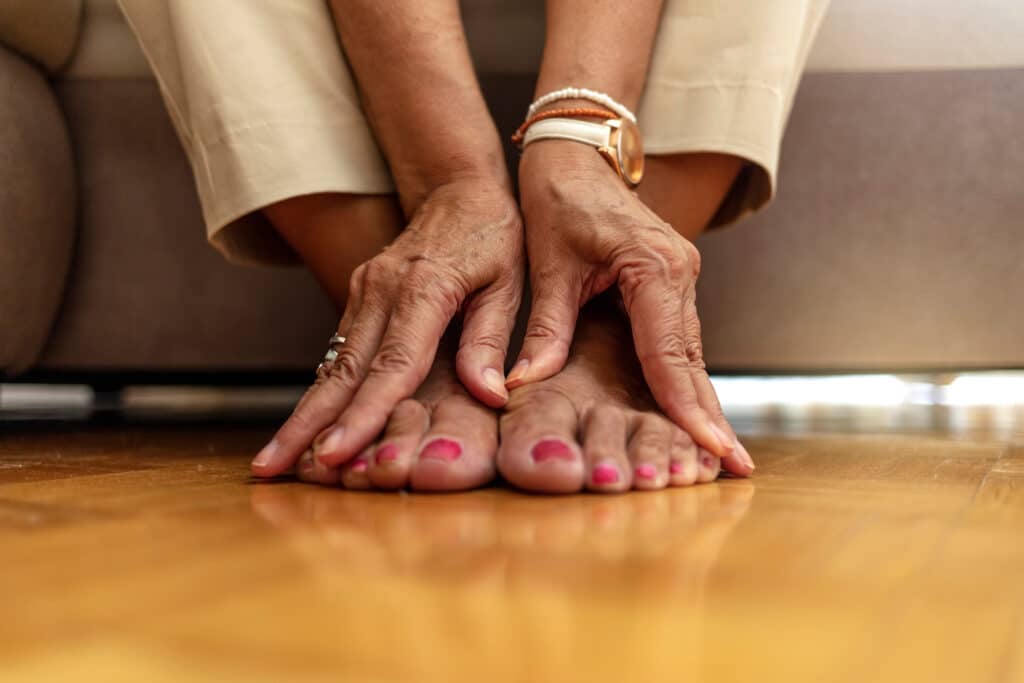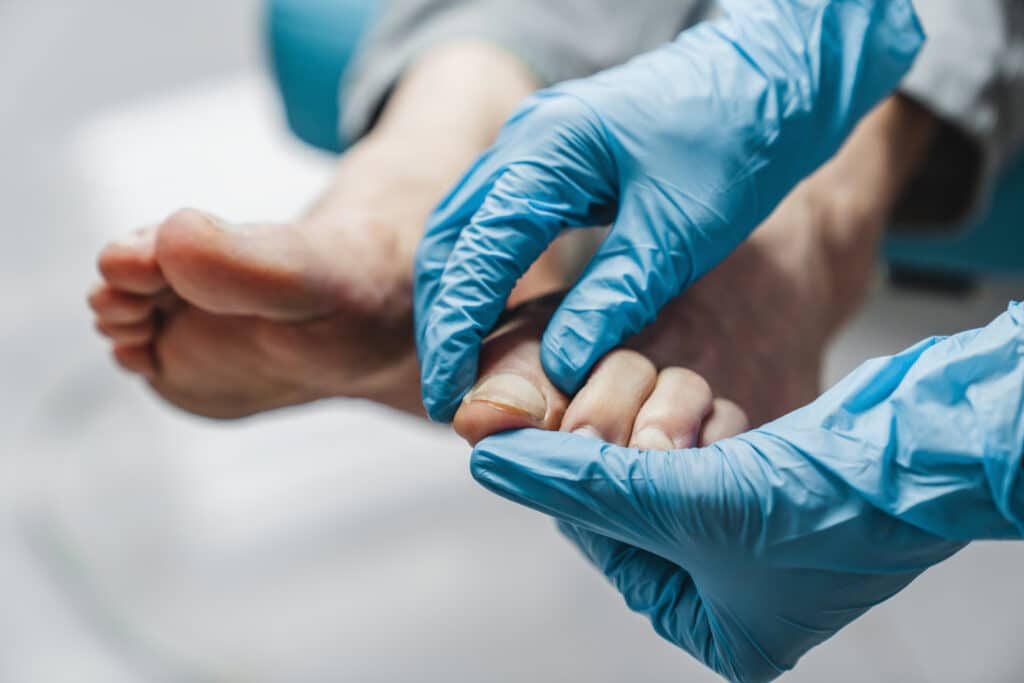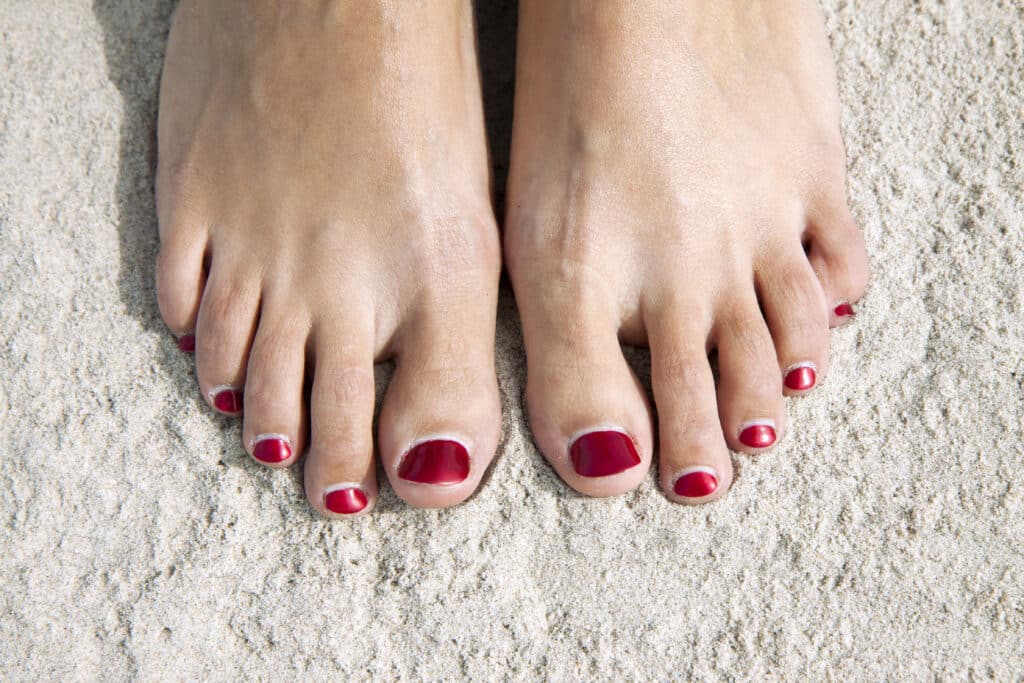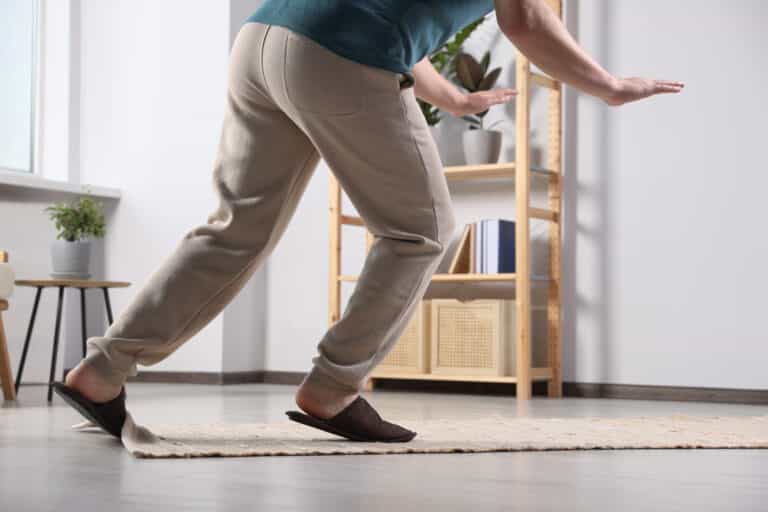As we age, taking care of our toenails becomes more important than ever, but it can also be more difficult for various reasons. Sometimes, toenail care might slip when dealing with other health issues.
Toenail care is more than just looking good — it’s key for staying healthy and comfortable in our senior years. Ignoring it can lead to preventable problems like infections, and it can even make conditions like diabetes worse. Issues like ingrown toenails can get in the way of staying active and enjoying our daily lives.
The good news is that we can keep our feet in great shape with simple measures like using proper nail trimming techniques, keeping our feet clean, and keeping an eye on any changes that might influence our foot health. It’s all about giving our feet the care they need to keep us moving and feeling good.
In this article, we’ll explore best practices for good foot hygiene for seniors and some of the lesser-known pitfalls for neglecting this easily overlooked component of your self-care practice.
Common Toenail Hygiene Barriers for Seniors

Caring for our toenails can become more physically and mentally challenging with age due to various factors impacting physical health, memory, and mobility.
Here are a few common reasons why toenail care might become more difficult for older adults.
Reduced Flexibility and Range of Motion
With age, reduced flexibility and range of motion can become significant obstacles in performing routine foot care, including toenail maintenance. Stiffening joints and decreased spinal mobility often make it difficult to reach the feet comfortably.
In my practice, I emphasize exercises that enhance mobility, focusing on maintaining the flexibility necessary for effective foot hygiene. While touching your toes is not always a good measure of flexibility, it does give you an idea of how easy it might be to take care of your feet.
Simply leaning forward in a seated position is not just a good low back stretch; it is also a measure of how easy it will be to practice toenail care regularly.
Vision Impairment
Diminished eyesight, a common aspect of aging, can complicate toenail care by making it challenging to handle small details accurately. This issue affects the precision needed for toenail trimming and raises concerns about safety and the potential for accidental injury.
If you find yourself struggling to use regular nail trimmers or being able to see your feet, talk to your doctor about resources to keep your toenails healthy.
Arthritis and Joint Pain
Arthritis and other conditions causing joint pain can significantly hinder the ability to perform tasks requiring fine motor skills, such as toenail trimming.
It’s essential to explore ergonomic tools or techniques that minimize discomfort while ensuring proper foot care. Customized tools can assist in proper toenail care if you need more accessible options.
Cognitive Decline
Cognitive changes, including memory decline, can disrupt regular self-care routines. For those experiencing such challenges, setting reminders or visual cues can be an effective strategy to ensure consistent toenail maintenance.
Risk of Falls
For many seniors, the fear of falling while reaching down to care for their toenails is a real concern. This is one of many reasons that working on balance should be a central focus for all seniors.
In my work with patients, I focus on exercises that improve balance and stability, reducing the risk of falls and boosting confidence in performing essential tasks like toenail care.
If you cannot stably lean forward to address toenail issues, talk to your physical therapist to develop a plan to address mobility and balance issues.
Other Health Conditions
Chronic health issues, such as cardiovascular or respiratory conditions, can also affect the energy and stamina required for foot care. Recognizing these limitations is crucial in adapting toenail care practices to accommodate overall health and well-being.
Addressing these challenges with understanding and appropriate strategies is key to ensuring effective and safe toenail care for older adults. Whether through adaptive tools or assistance from caregivers, the goal is to maintain optimal toenail health as a vital part of overall senior care.
Common Conditions Affecting Nail Health

Fungal and Bacterial Infections: More Than Just an Aesthetic Concern
Our toenails can become more vulnerable to fungal and bacterial infections. Changes in nail structure and a natural decline in immune function make these infections more likely in older adults.
Fungal infections, thriving in warm, damp conditions, often cause nails to discolor and thicken. Bacterial infections, on the other hand, might start from small cuts near the nail bed.
For those with weaker immune systems or poor circulation, these can escalate into painful swelling, pus formation, and even damage to the nail matrix. It’s essential to treat these infections promptly to prevent further complications.
Neuropathy: When Feeling Less Means More Risk
Neuropathy, affecting nerves and sensation, can significantly impact toenail health. This condition means less foot sensitivity, making it hard to notice injuries or infections.
The lack of pain or discomfort as an early warning sign often leads to delayed treatment. This can escalate to serious infections or injuries for seniors, complicating overall foot health.
Regular monitoring and care are crucial to avoid inadvertent injuries that can harm toenail health.
Diabetes and Toenail Health: A Delicate Balance
Diabetes adds another layer of complexity to toenail care. Here’s what to keep in mind:
- Impaired Blood Circulation: Diabetes often leads to poor circulation in the feet. This means less nutrition and oxygen for toenails, raising the risk of infections and slow healing.
- Compromised Immune Function: A weakened immune system, common in diabetes, can struggle to fight infections, making toenails more prone to problems.
- Nail Changes: Diabetes can cause nails to thicken, change color, or grow more slowly, making regular care challenging.
- Risk of Ingrown Toenails: Changes in nail structure and poor circulation increase the risk of ingrown toenails in diabetic individuals. Left unchecked, this can lead to serious infections.
- Peripheral Neuropathy: Many with diabetes experience nerve damage in their feet, reducing their ability to feel and detect toenail issues early. Regular checks are key for early intervention.
- Importance of Professional Foot Care: Regular podiatrist visits are crucial for diabetic individuals. Professional care can include nail trimming, early complication detection, and daily care guidance.
For those managing diabetes, staying proactive and informed about toenail care is vital. Regular professional check-ups and diligent daily care are essential to maintaining healthy feet and overall well-being.
Understanding the Impact of Poor Nail Health
While nail health might seem an unimportant concern to some, many seniors have learned the importance of toenail care the hard way.
Here are a few of the most common ailments that can develop from poor toenail care.
Ingrown Toenails
Ingrown toenails, where the nail grows into the skin, are more than just a source of pain and redness. They can lead to serious problems if not addressed properly. The skin around an ingrown toenail becomes a hotspot for bacterial or fungal infections, especially with an open wound.
For those with health conditions like diabetes, the risk of complications increases. Knowing how to prevent and manage ingrown toenails is vital for avoiding these issues.
Ulcers and Wounds
Ignoring toenail health can lead to skin problems, including ulcers and wounds. These issues aren’t just painful; they can also invite infections and slow healing.
Open wounds from poor nail care are gateways for bacteria and fungi, raising the chance of chronic infections. These wounds can severely impact mobility and overall foot health, making routine care necessary.
Chronic Pain and Discomfort
Poor toenail care goes beyond the nails. It can cause pain and discomfort, limiting mobility and affecting daily life.
Like many other conditions, problems with your toes can deter your ability to move well. As a result, you may be limited by preventable issues like irritation or infection, resulting in an overall decline in quality of life.
For this reason, chronic toenail pain isn’t just physical; it can also take a toll on mental health, leading to stress or even depression.
In my practice, I examine a patient’s feet and nails to assess their hygiene routine, as it’s a key indicator of overall foot health.
Proactive nail care is crucial to avoid these complications. Regular checks, correct trimming, and professional guidance are simple steps that make a big difference.
By staying vigilant with these practices, seniors can enjoy healthier, happier feet in whatever activities they enjoy.
Actionable Ways to Maintain Nail Health

Proactive toenail care ensures happy and healthy feet, especially as we age. Let’s explore some effective ways to maintain optimal toenail health:
Proper Trimming Techniques
The Right Way to Trim: It’s important to practice correct trimming techniques to prevent complications like ingrown toenails.
You should use specialized clippers or scissors designed for toenails for best results. Remember to trim straight across and not round the corners, which helps reduce the risk of ingrown nails. Regular, gentle trimming keeps your nails neat and supports overall foot health.
Helpful Tools: Consider using clippers made for thicker nails, nail nippers for better leverage, or electric nail trimmers for ease. A nail file can smooth rough edges post-trimming, minimizing the risk of snags.
Additional Aids: For those with visual challenges or difficulty reaching their feet, tools like a magnifying glass, handheld mirror, or footrest can make a big difference. Softening nails with warm water or a cuticle softener before trimming can simplify the trimming process.
Seeking Assistance: If managing your toenail care is challenging, don’t hesitate to seek help from a caregiver or healthcare professional. The right approach and tools are crucial for healthy toenails.
Foot Hygiene Practices for Senior Toenail Care
Daily Foot Care: Regular cleaning and drying of your feet form the cornerstone of toenail health. Use mild soap and warm water for washing, and ensure thorough drying, particularly between the toes.
Opt for moisture-wicking socks and breathable shoes to keep your feet dry and reduce the risk of fungal infections. Well-fitting shoes are also important to minimize pressure on the toenails and lower the chance of ingrown nails.
Monitoring for Signs of Issues
Stay Alert: Regularly inspect your toenails for any changes in color, thickness, or signs of infection. If you have trouble reaching your feet, use a mirror or ask for help if possible.
Prompt Action: Address any unusual changes promptly and consult a healthcare professional for proper guidance and intervention.
Incorporating these practices into your routine is key to preventing common toenail issues and enhancing your overall quality of life. Healthy feet are vital for a comfortable and active lifestyle, particularly as we age.
Key Takeaways
- With age, the importance of toenail care escalates due to increasing challenges like reduced flexibility and vision impairment, which can complicate routine foot care.
- Proper toenail trimming, requiring specialized tools and techniques, is essential to prevent common problems such as ingrown nails, often caused by incorrect trimming methods.
- Daily foot hygiene is crucial for preventing infections; this includes thorough washing and drying of the feet and wearing suitable socks and shoes to maintain a healthy foot environment.
- Regular self-examinations of toenails are vital for early detection of potential problems, enabling timely intervention and preventing the escalation of minor issues into serious complications.
- For seniors, especially those with health conditions like diabetes, professional toenail care is advantageous as it helps manage specific risks associated with their condition and ensures safe and appropriate foot care.
- Neglecting toenail health can have serious consequences, leading to complications such as infections, chronic pain, and reduced mobility, significantly impacting a senior’s quality of life.
- Establishing a comprehensive foot care routine, which includes meticulous toenail trimming and consistent monitoring, is key to maintaining healthy toenails and preventing the adverse effects of poor foot care.
Summary
With age, the importance of maintaining toenail health becomes increasingly apparent. Our golden years often present new challenges in foot care, such as decreased flexibility and diminished vision, making routine tasks like toenail trimming more difficult.
Embracing proper trimming techniques and using the right tools are essential to avoiding complications, particularly ingrown toenails. Furthermore, consistent foot hygiene practices are crucial in warding off infections. Seniors should also regularly inspect their toenails for early detection of potential issues.
For those with certain health conditions, such as diabetes, professional care becomes even more critical. Neglecting toenail health isn’t just a matter of discomfort; it can lead to more serious issues, including infections, chronic pain, and impaired mobility.
Adopting a thorough and regular foot care routine is essential for sustaining toenail health and, by extension, an active and comfortable lifestyle in the senior years.
References
- Abdullah, L., & Abbas, O. (2011). Common nail changes and disorders in older people: Diagnosis and management. Canadian Family Physician, 57(2), 173-181.
- Chan, H. Y., Lee, D. T., Leung, E. M., Man, C. W., Lai, K. M., Leung, M. W., & Wong, I. K. (2012). The effects of a foot and toenail care protocol for older adults. Geriatric Nursing, 33(6), 446-453.
- James, K., Orkaby, A. R., & Schwartz, A. W. (2021). Foot examination for older adults. The American journal of medicine, 134(1), 30-35.







